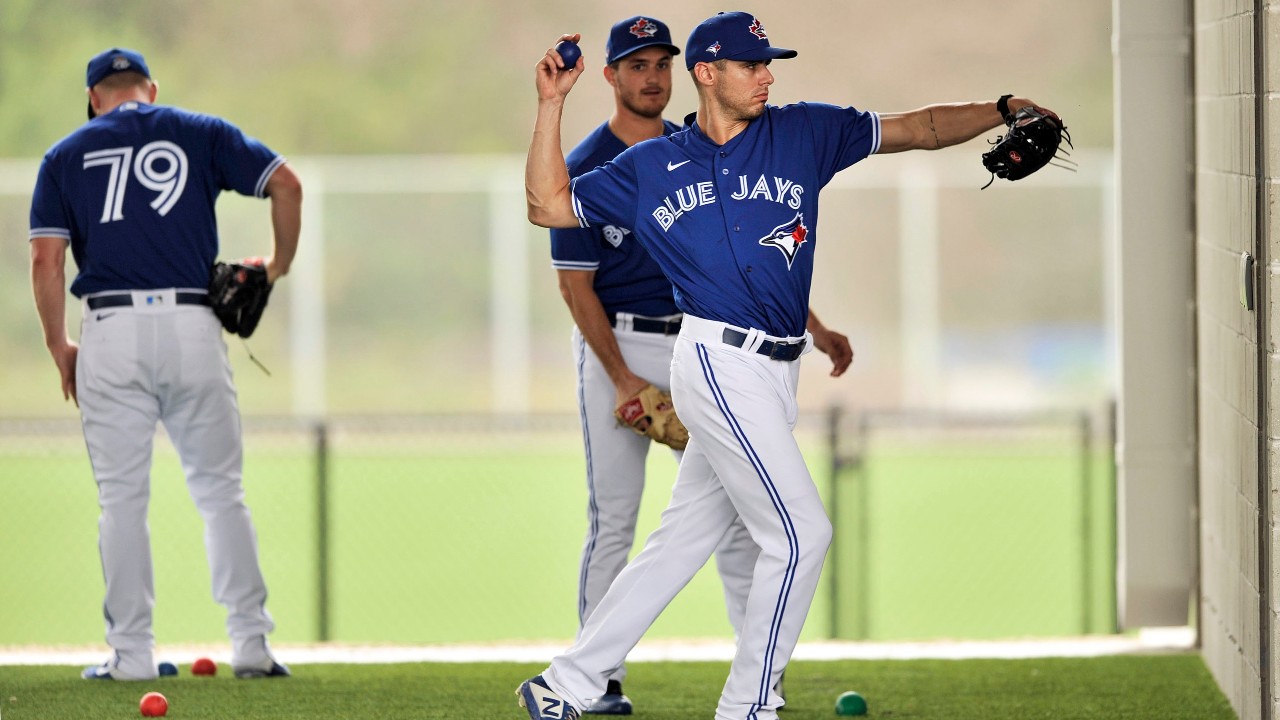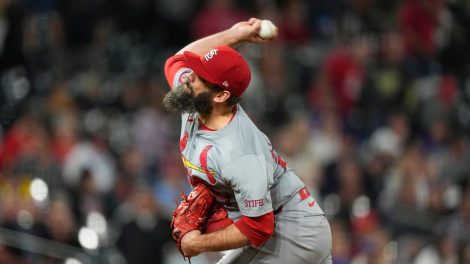Do you reckon Julian Merryweather was a little nervous for his MLB debut? Maybe the massively missed location of his first pitch provides a hint:
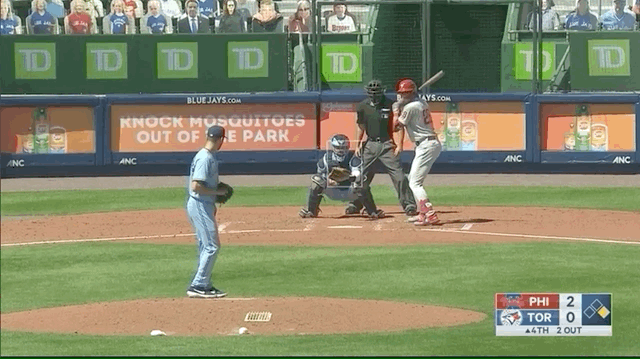
Or maybe it was what happened when Blue Jays catcher Reese McGuire threw him back the ball after his second:

Oh, the indignity. And yet you couldn’t be more wrong. You see, Merryweather — who earned his first big-league call-up on Tuesday — very nearly made his debut with the Toronto Blue Jays a couple times this week while the club was in Baltimore playing the Orioles. He warmed up in the bullpen, which got the nerves going plenty even though he never actually entered a game.
He figures that got most of the anxiety out of his system. Which still doesn’t quite explain dropping the ball. Not that any pitcher ever wants to have to try to explain that.
“Dropping the ball was like, ‘Geez, I just look like an idiot right there,’” Merryweather said. “But it wasn’t really nerves. I was pretty calm once I finally got out there. I’ve got to say, I was more nervous warming up for some of the Orioles games. Just getting those initial jitters of thinking you’re going out there. So, I felt like I was a little more calm for an actual debut.”
He certainly looked it after those first two pitches, quickly dialling in and retiring four of the five Philadelphia Phillies he faced — three via strikeout. Just look at this one of Roman Quinn, starting with Merryweather locating a 98 mph heater down-and-away in a fastball count:
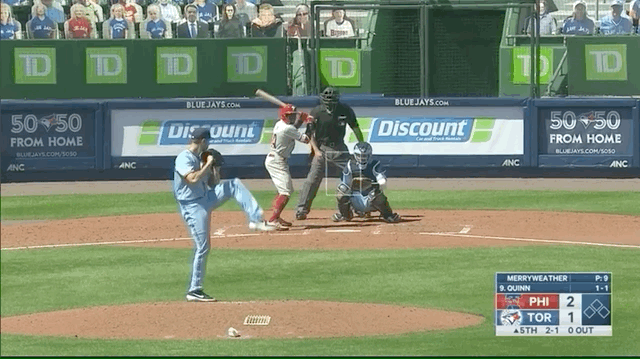
With two strikes, he immediately came back inside with 98 on the hands:
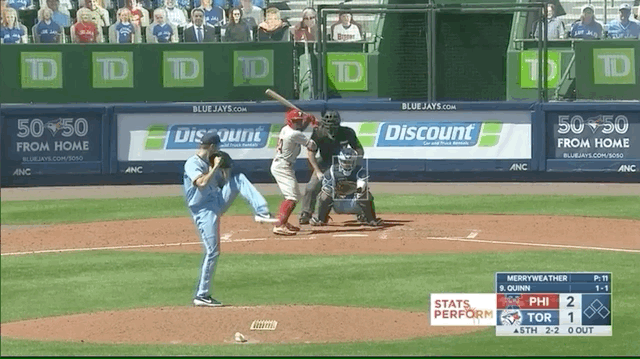
After those two straight heaters, he got Quinn way out in front taking an emergency cut on a changeup:
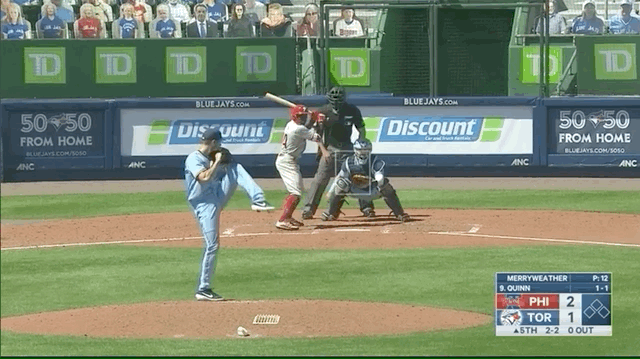
And finally, Merryweather froze him with a nothing-you-can-do-with-it curveball up-and-in:

That’s not where Merryweather wanted that curveball to end up, mind you. He was trying to bury it. But it didn’t end up mattering. The ball moved so much and Quinn was so unsure of what pitch he was about to get that all he could do was watch it fall in for a strike.
“I was trying to throw it as hard as I could and that’s where it ended up,” Merryweather admitted. “I think probably a better pitch would’ve been a little more down. But I think the fact that it was so high kind of caught him off guard. It worked in that situation. But probably not exactly where I want to throw it, no.
“My whole thought process going in was, ‘Hey, just let it eat. Be aggressive. Attack the zone.’ So, I was really throwing everything as hard as I could, to be honest. A few sliders got away from me. But, hey, as long as they play in the zone somewhere, I’m happy with it.”
Here’s that slider, which Merryweather threw a half-dozen times in Thursday’s outing, playing in the zone like he wants it to:
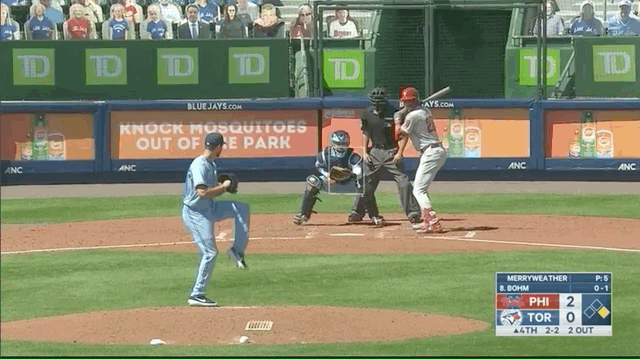
So, to recap: there’s a fastball he’ll run up to the high-90s located on either side of the plate, with a hard slider, slow curveball and fading changeup all working off of it. There’s nearly a 20-mph discrepancy from Merryweather’s hardest pitch to his softest, while all three secondary weapons move in different directions, making him an extremely difficult hitter to square up when he’s locating everything for strikes.
It’s a starter’s repertoire, really, which is why he spent his entire career starting games in Cleveland’s organization prior to being traded to the Blue Jays. But Tommy John surgery in 2018, a setback during an aborted return in 2019, and the minor matter of a global pandemic in 2020 all conspired to bring him here — finally making his MLB debut at age 28, as a reliever, pitching at a triple-A ballpark in a seven-inning game with no fans in the stands, more than six years after the day he was drafted.
“To finally take that jog out there to the mound, I mean, so many emotions, so many thoughts coming to my head,” he said. “But once I got out there I was just really locked into the game and not letting any of that affect me. It was definitely the biggest adrenaline rush in my life. I mean, that wiped me out pretty good.
“But I think it was good to get that first one out of the way. Now, I can really work on sharpening it up even more.”
Also notable was the situation Montoyo chose for Merryweather’s entry point. Fourth inning, two outs, runner on first. Blue Jays starter Chase Anderson was at only 78 pitches and had retired four of his last five — Montoyo certainly would’ve been justified letting him try to get the final out of the inning and giving Merryweather a clean slate in the fifth.
But instead he challenged Merryweather with a high-pressure situation, then had him retake the mound after sitting through a half-inning in which the Blue Jays brought seven batters to the plate. It wasn’t an accident.
These are the kinds of spots the Blue Jays will ask Merryweather to handle this season, and potentially going forward throughout his big-league career. Taking over with runners on, protecting slim leads or deficits, facing upwards of five batters, logging multiple innings.
“He’s the same kind of deal like [Thomas] Hatch and [Anthony] Kay,” Montoyo said. “Stretch him out a little bit like that.”
The Blue Jays have certainly found ways to maximize their roster this season, repurposing starting depth that would have formed the triple-A rotation like Hatch, Kay and Jacob Waguespack as multi-inning relievers who can piggyback off starters or chew up a couple leverage frames later in games. Hatch has pitched 11.3 innings over his six relief appearances, while Kay has logged 11.1 over his half-dozen.
Ryan Borucki ought to be included in that group, too, although he’s been featured in shorter, one-inning bursts. The lifetime starter has been dominant in the role, allowing only two hits and six walks over 7.2 scoreless innings. And his peripheral stats jump right off the chart, putting him among the class of the league:
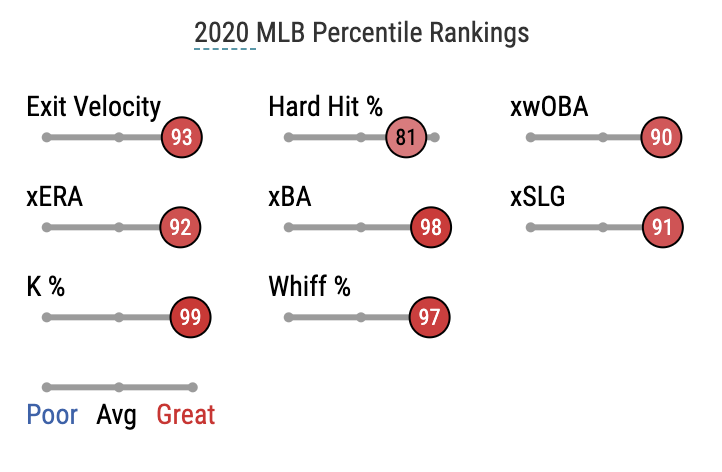
And Borucki’s different for another reason. While Hatch and Kay could resume as starters next season, Borucki’s likely sticking around in the bullpen permanently. He might just do it in a somewhat unique role.
“Maybe there’s more length to some of his outings and he’s complementing the team in a different way, in a bulkier way,” said Blue Jays GM Ross Atkins. “He could end up with an 80-to-100 inning season in a 162-game schedule.”
There’s real value there if you can find the right guy. Yusmeiro Petit put up 1.4 fWAR last season while logging 83 innings out of Oakland’s bullpen and pitched to an even 3.00 ERA over 93 relief innings the season prior. Seth Lugo stretched 19 of his 61 relief appearances in 2019 to two innings or more, giving the New York Mets 2.3 fWAR over 80 innings at a 2.70 ERA, much of it in high leverage.
Josh Hader — the lights-out Milwaukee Brewers closer — is an absolute best-case scenario. The two-time All-Star’s pitched to a 2.33 ERA over 158 relief outings since he entered the league in 2017. But nearly a third of those appearances have been for two innings or longer, making him even more valuable than your traditional, one-inning closer. It’s part of the reason why Hader’s put up 6.4 fWAR since 2017, more than Madison Bumgarner (5.8 fWAR over that span) who signed a five-year, $85-million contract last off-season.
Hader’s stuff is exceptional, of course. Although it’s not for nothing that Borucki’s throwing his fastball harder than Hader’s this season, and getting a better whiff rate with his slider. It’s still an extremely tall measuring stick to line him up against. But Borucki’s stuff is just as good as Lugo’s and far better than Petit’s, making their 1.5-2.5 WAR range a not unreasonable possibility for Borucki if he were in a similar role.
Can you name the last Blue Jays reliever to provide north of two wins above replacement? It was Roberto Osuna in 2017. That’s the only time its happened since B.J. Ryan did it in 2006. And before him you have to go back to Duane Ward nearly 30 years ago. Getting that kind of value out of a bullpen arm is not a luxury this organization has often enjoyed.
[snippet id=4931337]
Now, it’s easy to get carried away here. Borucki’s been a reliever for less than a month. He’s made only eight bullpen appearances in his life. He has a well-documented injury history, the league hasn’t yet had a chance to adjust to him, and he’s struggled to find the strike zone his last couple times out. Things might not always go so well.
But the potential of a Petit or a Lugo or even a Hader outcome is the reason why the Blue Jays are trying one-time starters like Borucki and Merryweather in that role. This was always the gambit with acquiring as much young starting pitching as the organization has over the last several seasons.
You certainly hope as many as possible become starters in your big-league rotation. That’s the model upshot. But of the ones that inevitably don’t, some will prove not up to the level, some could end up in trade packages, and some may end up providing value out of the bullpen on contending Blue Jays clubs.
That’s essentially what Borucki, Hatch and Kay have been doing this season. And you may be able to add Merryweather’s name to that list soon. He plans to continue throwing all four of his pitches in relief, giving him a variety of ways to attack hitters as he stretches outings from one inning to two. Or he could always just rear back in a shorter stint and challenge with 98. That’ll always play.
Health will be key. Effectiveness, too. But as things stand today, Merryweather’s working with both. And the Blue Jays bullpen just keeps getting stronger from within.
“I’m a guy who can go multiple innings if you need me to. I’m able to lengthen out here and there. Or I could come in for one inning with just all power stuff, too,” he said. “For me, the role isn’t a big deal. I’m just happy to be out here playing, helping the team. We have a great bullpen. And it’s just fun to be a part of.”
[relatedlinks]
